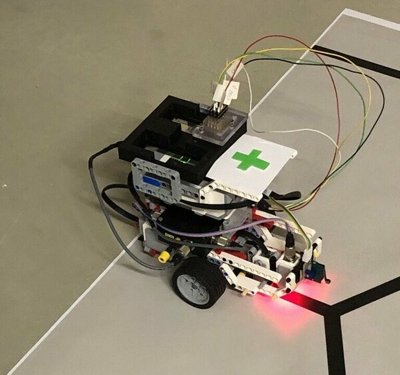Our brain as an example
TU/e researcher Imke Krauhausen built new electronic devices based on neuromorphic computing.
Our brain can process complex information at lightning speed using very little energy. This is why there is rapidly growing interest in the human brain as a model for the development of new computer technology. TU/e researcher Imke Krauhausen built new electronic devices based on neuromorphic computing. By using organic materials, she hopes that her artificial synapses will eventually be used for applications in the human body. On Wednesday April 10th, Krauhausen defended her doctoral research cum laude at the department of Mechanical Engineering.
As a young child, she mainly played with Playmobil, Krauhausen explains somewhat regretfully. “It’s only now that I’ve discovered how much fun Lego really is.”
At the beginning of her PhD track, she found herself diving into a giant container of building blocks to assemble a robot designed to help her with her experiments. Krauhausen wanted to see if she could teach this robot to navigate a maze.
But the most remarkable part is inside the robot itself: it is controlled by a neuromorphic circuit. “In the lab, we developed artificial synapses – flexible connections that enable the individual neurons in our brain to communicate with each other. We make these synapses with organic polymers that the human body can tolerate. Because eventually, we want to start using them for applications within the body: a smart prosthesis or a sensor capable of adapting inside your body.”
Super-efficient
For some time now, researchers have been studying the functioning of our brain as an example for the development of a new generation of computer systems.
Since we are increasingly using smart devices and artificial intelligence, we also need new, and above all, more energy-efficient computer technology, Krauhausen explains. “And our brains are very good at that. They use a mere 20 watts per hour for very complex tasks, something even the most ingenious supercomputer is nowhere near achieving. Our brain is a great source of inspiration.”

The smart robot controlled by neuromorphic computing. Photo: Imke Krauhausen.
Whereas traditional computer chips consist of silicon and metal, TU/e research group Neuromorphic Engineering is working on an organic system based on water and salt, just like our brains. There, synapses can transmit electrical signals thanks to an ingenious system of salts and salt-gated channels.
The electronic circuits used by Krauhausen also have such a salt channel. “A very small one, though, think about 100 to 200 micrometers. So that meant a lot of microscopy work in the cleanroom. Within our group, we work with several researchers on different aspects of the same artificial neuronal system. This ranges from developing new organic materials and researching new algorithms to fine-tuning the device’s mechanical behavior."
.....
Learn more about the technique of Krauhausen by reading the whole article.



